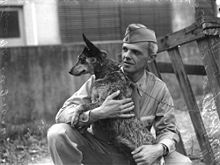source: Wikipedia, The Free Encyclopedia
 An American soldier with a Cattle Dog in Queensland during Worldwar II, State Library of Queensland Collection An American soldier with a Cattle Dog in Queensland during Worldwar II, State Library of Queensland Collection |
|
In the 1940s Dr. Alan McNiven, a Sydney veterinarian, introduced Dingo, Kelpie, German Shepherd, and Kangaroo Hound into his breeding program; however the Royal Agricultural Society Kennel Club would not register the cross breeds as Australian Cattle Dogs, even though McNiven argued they were true to conformation, colour and temperament. McNiven responded by putting “dead papers” on his pups and was consequently expelled from the RASKC and all of his dogs removed from the registry. Meanwhile, Greg Lougher, a Californian cattle rancher who met Alan McNiven while stationed in Australia during the War, had imported several adults and several litters from McNiven. After his de-registration McNiven continued to export his “improved” In the late 1950s a veterinarian in Santa Rosa, California, Jack Woolsey, was introduced to Lougher’s dogs. With his partners, he bought several dogs and started breeding them. The breeders advertised the dogs in “Western Horsemen” stating they were guaranteed to work and calling them Queensland Heelers. Woolsey imported several pure-bred Australian Cattle Dogs to add to his breeding program; Oaklea Australian Cattle Dogs had been in the miscellaneous classification at the American Kennel Club since the 1930s, but in order to get the breed full AKC Championship recognition, the AKC required that a National Breed Parent Club should be organized for promotion and protection of the breed. In 1967 Esther Ekman met Chris Smith-Risk at an AKC show, and the two fell into conversation about their Australian Cattle Dogs and the process of establishing a parent club for the breed. By 1969 the fledgling club had 12 members and formally applied to the AKC for instructions. One of the requirements was that the Club had to start keeping its own registry for the breed and that all dogs on the registry would have to be an extension of the Australian registry, tracing back to registered dogs in Australia. The AKC Parent Club members began researching their dogs, including exchanging correspondence with McNiven, and discovered that few of them had dogs that could be traced back to dogs registered in Australia. New imports from Australian breeders had to be made, whose stock was registered under the Australian Kennel Club. The AKC took over the club registry in 1979 and the breed was fully recognized in Sept. 1980. The Australian Cattle Dog Club of America is still a vital force in the promotion of the breed and the maintenance of breed standards. The National Stock Dog Registry continued to recognise Cattle Dogs without prerequisite links to Australian registered dogs, on the condition that any dog of unknown parentage that was presented for registry, would be registered as an “American Cattle Dog” and all others would still be registered as “Australian Cattle Dogs.” |
copyright © Doris Duewel, all rights reserved / webmaster : Doris
